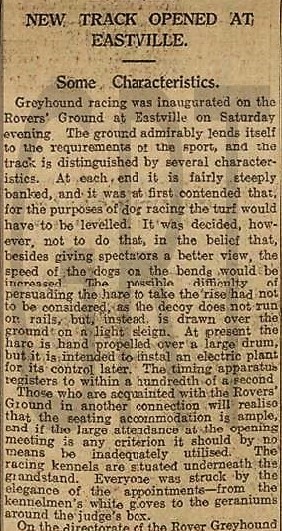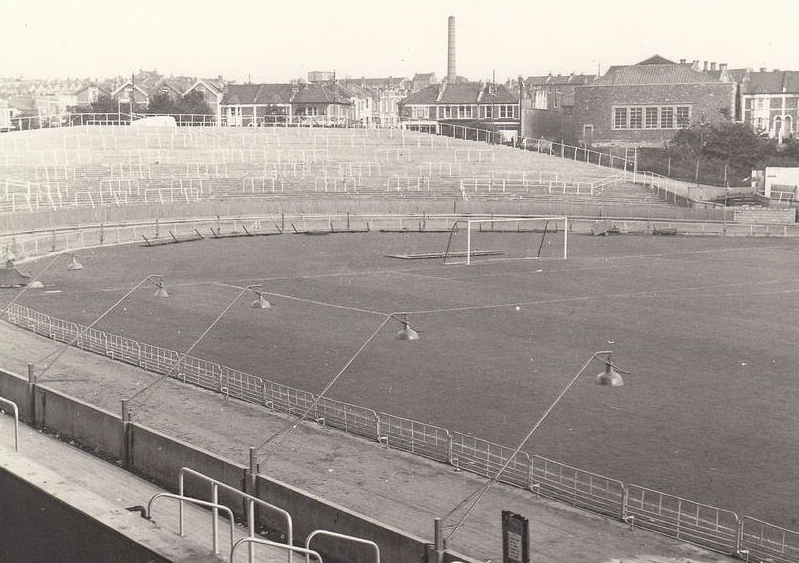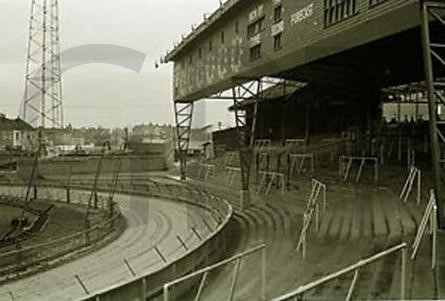Bristol Rovers Football Club, Stapleton Road, Eastville, Bristol
POSTCODE———————————-BS5 6XX
LOCATED————————————West of the M32 about two and a half miles north east of Bristol city centre.
ORIGINAL SITE—————————–Developed during the latter end of the nineteenth century as a Football and Rugby Ground.
DATE CONSTRUCTED——————–1897
DATE VENUE OPENED——————-April 1897 when Bristol Rovers played a fixture against Aston Villa.
Meaning other sports may have taken place prior to the arrival of Greyhound Racing.
FIRST MEETING—————————–June 16th 1928. Closed for winter period October 1928. Had a period of closure, but opened again on 16th July 1932.
Greyhound Racing only.
LICENSED OR INDEPENDENT———-NGRC.
All venues covered would have to be licensed with the government, licensed suggested in this section would refer to tracks operating under NGRC Rules.
INSIDE OR OUTSIDE HARE TYPE——Inside but mainly outside Bramwich.
Please note that the Electric Hare suggested is only a guidance and would have been in operation for a certain amount of time at this venue. Although it is not necessarily guaranteed that it was operational all the time, as other types of lure may have been used and updated as time progressed.
DISTANCES———————————–266, 470, 670 and 874 metres.
Please note that most racing venues distances had become varied throughout the years, the ones given above were at once point set and offers only a guidance to the track size.
CIRCUMFERENCE—————————404 metres.
Please note that alterations at most racing venues throughout its existence would see that the circumference of the track would vary, the one shown above offers only a guidance to the track size.
BIG RACE NAMES—————————The Golden Crest and The Western Produce Stakes.
STADIUM SHARED WITH——————Bristol Rovers Football Club and Speedway.
LAST MEETING——————————-October 27th 1997.
Greyhound Racing only.
STADIUM CLOSURE DATE—————-October 1997.
Meaning other sports may have taken place after Greyhound Racing had ceased.
STADIUM DEMOLITION——————-1998 although the last remaining Floodlight pylon would overlook the site for the next five years or so before that too became demolished.
BUILT ON SITE——————————-An Ikea Furniture Store.
In some cases, structure’s that originally covered the venue after the stadium had been demolished, may have been themselves demolished too, so the one described is more likely to be the one which now presently covers the site.
EVIDENCE LEFT TODAY——————-Nothing known of.
FURTHER COMMENTS——————–Bristol Rovers last match at Eastville was against Chesterfield on the 26th of April 1986, with 3,576 attending the match.

























Eastville is a district of Bristol, located about two and a half miles north east of its city centre, more commonly known for playing a massive part in the history of Bristol Rovers Football Club. You could say it was classed as a football stadium, but it was Greyhound Racing that featured more than anything else, keeping the stadium alive throughout its years of turmoil.
Originally the site had been a rugby pitch that had developed on grazing land between a gas works, and the River Frome. Stapleton Road as it was known then, began to take shape as a football stadium, after Bristol Rovers had shared the ground with Harlequins Rugby Club up until 1896. Having purchased the ground for £150, Bristol Rovers played their officially opening match against Aston Villa on the 3rd of April 1897. The football club instantly changed the grounds name to Eastville, although it became known as The Ville to its regulars.
In 1928, a greyhound company approached the committee of Bristol City Football Club with a view to stage Greyhound Racing at Ashton Gate, but their refusal triggered an approach towards The Eastville Owners, whose response became far more positive. After overcoming objections from nearby church leaders, a track was laid around the football pitch, along with a cluster of kennels, which had been constructed beneath the main stand.
On the 16th of June 1928, Eastville witnessed its first greyhound meeting under rules similar to those of the NGRC, with a greyhound called Vivacious winning the first event over the 500-yard trip. The beginning of October had seen Greyhound Racing suspended for the winter months, but surprisingly the sport did not feature again until almost four years later.
Greyhound Racing returned to Eastville on the 16th of July 1932, but this time it was here to stay as attendances regularly outnumbered those of first team football matches. Greyhounds Racing proved to be a profitable business at Eastville, but it wasn’t the case for the football club, who by 1939 had found themselves in serious financial trouble. It was during this period that Eastville experienced some strange goings on, with the stadium being sold by the chairman of Bristol Rovers to The Greyhound Company for £12,000, without discussing it with fellow directors.
The outbreak of The Second World War had seen the number of football matches vastly reduced, yet Greyhound Racing remained hardly unaffected, operating afternoon meetings only and still attracting gates well in excess of 4,000. The post war years had seen average crowds rising to 6,000, with as many as 60 Bookmakers in attendance. League football returned once again with Bristol Rovers FC this time moving in as tenants, and that is how it would continue over the next forty years or so. Attendances at football matches began to improve, and it became a period that Bristol Rovers would set a ground record attendance of 39,462 during an FA Cup tie against Preston North End in January 1960.
In 1967 the Bristol track became one of the earliest tracks to switch from a grass surface to a totally sanded one, a move which would start the trend at other Greyhound Racing venues around the UK. The early 1970’s had seen the construction of the close by M32 Motorway, so close was it that its hard shoulder created a superb viewing spectacle of the whole stadium. Other sports also featured at Eastville, firstly American Football, then Speedway arriving in 1977, with the same circuit being used by motorcycles and greyhounds, an idea which would see the track being relayed after every Speedway meeting, but this idea was short lived mainly due to the cost of maintenance.
But it was during the 1980’s that Eastville’s future began to look insecure, firstly on the 16th of August 1980 when the fifty-six-year-old South stand, which housed the dressing rooms and offices became totally destroyed by fire, a disaster which saw a loss of many Eastville’s historical documents. Worse was to follow for the Rovers, as home fixtures were losing the club around £2,000 every match and announced that they could not afford to carry on playing at Eastville anymore. Their final fixture came on the 26th of April 1986, when a crowd of 3,386 witnessed a 1-1 draw against Chesterfield. Although the Bristol football faithful had experienced some disastrous time in such a short spell, it wasn’t the end of Eastville, as Greyhound Racing was sensing a boom time, with a BAGS meetings contract secured during 1980, and with the football club now gone, a fourth meeting was added to the weekly schedule. Eastville was now promoting forty races per week, making it the busiest track in Britain, with an annual turnover of over half a million, ten times more than what the football club had achieved.
With big race events such as The Golden Crest and The Western Produce Stakes, it could now financially attract some of the better classed greyhounds from across the UK. 1991 witnessed the introduction of eight dog racing, but it was a brief spell only, as the idea failed to impress racegoers. It also became the year that saw the installation of an inside Bramwich hare system, even though an outside Bramwich hare was already in operation, it seemed that it could not cope with winters icy conditions, were the inside one remained trouble free. But the 1990’s was also witnessing the slow decline of attendances, and with no investment planned for an ever-increasing run-down Bristol Stadium, it came as no surprise that the venue had been sold to developers.
The last meeting to be staged at Eastville was on the 27th of October 1997, but it would take another twelve months before the bulldozers would move in. Although work had begun transforming the site, one last remaining floodlight pylon would overlook the new project for the next five years before that too was dismantled in 2003.
The site eventually transformed into a large retail park, with the site of the old stadium pinpointed by an Ikea Furniture Store, which had opened for business during March 1999. Although Greyhound Racing in Bristol had been lost forever, Bristol Rovers continued their existence firstly ground sharing at Bath City, before returning back to Bristol to play home fixtures at the cities Rugby Union Ground.

Recent Comments